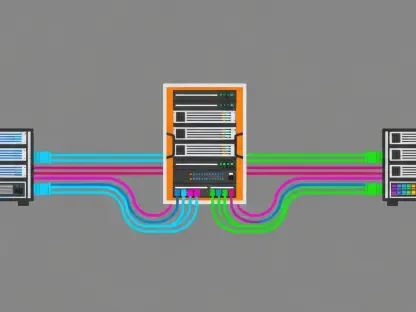In today’s rapidly evolving technological landscape, businesses need to stay ahead in a competitive market by embracing digital transformation. The core of this transformation is an intelligently structured network infrastructure that supports technologies such as artificial intelligence (AI), machine learning (ML), and hybrid multicloud environments. As organizations adopt these innovations, they face challenges like data fragmentation, managing disparate systems, and addressing security vulnerabilities. Consequently, there is an urgent need to converge network connectivity and security to form an integrated digital strategy that caters to modern demands.
The Convergence of Connectivity and Security
Bridging the Technology Gap
Connectivity and security now go hand-in-hand, constituting the foundation of any successful digital transformation endeavor. As digital tools proliferate, including the Internet of Things (IoT) and mobile solutions, businesses require a robust, intelligent network infrastructure capable of seamless integration across various platforms. A unified platform allows centralized management of connections and data sources, enabling streamlined operations and enhancing collaboration across departments. With an integrated approach, enterprises are better equipped to tackle operational inefficiencies, mitigate risks, and drive innovation.
Security challenges in today’s digital age cannot be overlooked, as cyber threats become increasingly sophisticated. Therefore, alongside connectivity, security measures must be enhanced to defend businesses against potential breaches. This means implementing comprehensive security frameworks that offer advanced solutions across both fixed networks and 5G environments. In doing so, companies can safeguard their data and maintain the integrity of their digital systems while ensuring easy accessibility for authorized users.
Achieving End-to-End Network Visibility
Ensuring end-to-end visibility into the entire network ecosystem is paramount for performance optimization and operational agility. Businesses can identify weaknesses or inefficiencies swiftly and make informed decisions to enhance network reliability. End-to-end visibility involves monitoring traffic flow, analyzing data patterns, and assessing usage trends to provide actionable insights. Maintaining a holistic overview allows enterprises to adapt to changing demands on the fly, scaling their operations as needed.
An intelligent network infrastructure enables businesses to achieve greater transparency in their operations. Knowing exactly what is occurring within the network allows prompt reaction to issues, maximizing uptime and minimizing disruption to services. This comprehensive visibility facilitates the creation of resilient, responsive systems that adequately meet the diverse requirements of modern business operations. The centralized management resulting from an integrated platform further supports this effort by streamlining network control processes.
Adopting Advanced Solutions for Network Management
Navigating Digital Transformation with AI-Driven Analytics
Modern network infrastructures increasingly incorporate AI-driven analytics to enable smarter decision-making. By leveraging AI and ML technologies, companies can process vast amounts of data efficiently, extracting insights that inform strategic choices. AI-driven analytics offer predictive capabilities, allowing businesses to anticipate system demands, identify potential threats, and optimize resource utilization. In this context, Singtel CUBΣ serves as a noteworthy example by providing integrated analytics solutions that facilitate these objectives.
AI-driven analytics empower businesses to shift from reactive to proactive management. Real-time data analysis helps understand evolving trends, enabling more accurate forecasting and planning. Integrating these insights into operations can significantly enhance network efficiency and responsiveness while reducing operational costs. The dynamic nature of these analytics tools allows companies to stay adaptive and innovative, maintaining an edge in the competitive digital environment.
Flexibility and Security in Network Operations
Flexible pricing models and robust security measures are critical components in modernizing network infrastructure. Businesses must navigate uncertain economic landscapes by adopting cost-effective solutions, which flexible models accommodate by aligning expenditures with actual usage. Such financial agility alleviates upfront capital expenditures (CapEx), freeing resources for further strategic investments. Companies find themselves more agile and better equipped to divert funds toward initiatives that drive growth and competitive advantage.
Security remains non-negotiable in digital transformation. Robust security frameworks ensure comprehensive protection against potential risks, safeguarding the business’s integrity. Addressing threats preemptively enables companies to focus on the core objective: innovation without interruptions. Coupling this with a focus on sustainability, enterprises can align operational practices with broader environmental goals. Optimizing their network infrastructure reduces carbon footprints, contributing to global sustainability efforts while thriving in an interconnected world.
Strategic Importance of Sustainable Network Infrastructure
Role of Partnerships in Optimizing Network Environments
Partnering with technology providers can streamline the process of transforming network environments. By collaborating with companies specializing in network solutions, businesses access enhanced expertise, cutting-edge technologies, and industry insights. Singtel exemplifies such partnerships by offering solutions that drive strategic management and operational alignment. These partnerships assist in integrating systems smoothly, ensuring compatibility and longevity, crucial for continuous, uninterrupted operations.
Partnerships facilitate resource-sharing and knowledge transfer, enabling businesses to capitalize on shared advancements in technology. Collaborating with partners committed to innovation accelerates their digital transformation journey, strengthens competitive stance, and embeds resiliency into operations. Through joint efforts, companies also advance toward achieving sustainability milestones, underscoring commitment to responsible business practices.
Aligning Strategy with Sustainability Goals
In the fast-paced world of technology today, businesses must keep pace to remain competitive, requiring embracing digital transformation. A well-designed network infrastructure is the backbone of this transformation, supporting advanced technologies such as artificial intelligence (AI), machine learning (ML), and hybrid multicloud environments. However, as companies integrate these innovations, they encounter numerous challenges. Data fragmentation becomes a common issue, necessitating effective management of disconnected systems, while security vulnerabilities present additional risks. To navigate this complex landscape, there’s an urgent need to merge network connectivity and security. By doing so, businesses can develop a comprehensive digital strategy that aligns with modern requirements. This integrated approach not only fosters operational efficiency but also enhances adaptability, ensuring that organizations remain resilient and competitive in an ever-evolving digital world. Addressing these challenges allows companies to effectively harness the power of digital transformation to drive growth and innovation.









